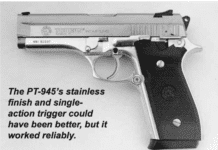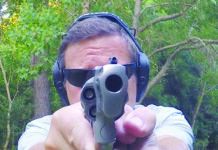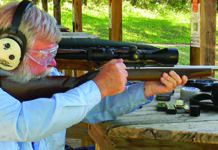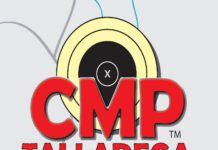AR-15 help
I am in the market for an AR-15. I haven’t shot an M16 since boot camp in Fort Polk, Louisiana, in 1974. I’ve been a cop for 25 years and never really wanted, or needed, a rifle during that time. Now that I’m semi-retired, I am looking and I need some straight talk and help. I want a good weapon, but there are so many manufacturers and options, I’m confused as hell. Because I was never in the war, I never experienced malfunctions. We always cleaned and over-lubed our Colts. My choice so far is a chrome-lined barrel, bore and bolt. Am I correct? I’m not sure on 1/7 or 1/9 twist rate. I will be using the rifle mainly for target shooting at 100 to 300 yards. Now they have the piston-driven action, which puts another kink in the process. I’m leaning toward a Rock River Arms product with a chromed bolt, barrel, and bore. They come with 1/9 twist. Best I could research, the 1/7 twist is only if you are shooting heavy mil-spec ammo. Please help me. I’m not planning on going to war with it, but I do want it to be reliable and able to take a little dirt without cleaning. Thank you for your help, I read Gun Tests as the Bible on firearms.
—Pete Piazza
via email
Well, we buy a lot of stuff. Some of it we’ve liked, other stuff, not so much. Log on to www.Gun-Tests.com and search for “AR-15” and you’ll get dozens of reviews to sort through. Or log on to our sister site, www.GunReports.com, and use the Gun Selector tool to narrow the search. ~Todd Woodard
Re “Ruger or S&W Battery Mates:
Which Would You Rather?” March 2011
I enjoy your magazine tremendously. While I don’t agree with everything you say, I value your opinions. However, in the Battery Mates article, you said, “In fact, both revolvers [the GP100 and 686] delivered impact to spring-loaded firing pins by way of a transfer bar.” This is incorrect. The GP100 does use a transfer bar to prevent the hammer reaching the firing pin unless the trigger is pulled. In this system the hammer cannot directly contact the firing pin. When the trigger is to the rear, the transfer bar is interposed between the hammer and firing pin. When the hammer is released, it contacts the transfer bar, and the two parts move forward together until the transfer bar hits the firing pin.
In the 686, on the other hand, the hammer must directly contact the firing pin to fire the revolver. This revolver’s design includes two separate features to prevent the hammer from reaching the firing pin with the trigger forward, but neither is a transfer bar. The first is the hammer/rebound safety system. This system consists of a lobe on the top of the rebound slide (the hammer seat) and a corresponding lobe on the hammer (the rebound seat). No, I didn’t get it backwards: the hammer seat really is on the rebound slide and vice versa. When the trigger is in the forward position, these lobes align and prevent the hammer from rotating far enough forward to strike the firing pin. The second is the hammer block. This part is interposed between the hammer and firing pin when the trigger is to the front to prevent the hammer from reaching the firing pin.
An easy way to tell the difference is to observe the hammer recess when the gun is cocked. A transfer bar will be in its upper position covering the firing pin, while a hammer block will be in its lower position. Does this error affect the conclusions of the article? Probably not.
—John Collins
Leesburg, Virginia
John, that’s a good catch. Thank you for pointing it out. The guilty parties have been appropriately shamed, but we still owe you and all our readers a concise explanation that would fit into the original text. Here it is:
“The Smith & Wesson 686 had an internal hammer block that stayed in place until the trigger action pulled the safety block down and out of the way, allowing the hammer to move forward enough to strike the firing pin. This is opposite of the GP100, wherein the trigger action moved the transfer bar upward between the hammer and firing pin. This enabled the energy of the hammer to be transferred to the firing pin.”
~Roger Eckstine
Re: “Two Tokarevs: Yugoslav M57 Outshines
Romanian TT-33‚” February 2011
In your article, several times you refer to the Romanian pistol as a “TT-33.” The Romanian Cugir manufactured “Tokarev‚” is actually the “TTC.” I was a little disappointed that the TTC only graded out to a “B.” I can understand that it was second choice in comparison to the Yugoslavian M57, especially in consideration of the Yugo’s lower price. My question is this: Had you obtained a little better TTC for a more reasonable price, would you have rated the Romanian higher than a “B”?
In December, I purchased a TTC for $175 through Southern Ohio Guns (SOG), the same source for your M57. The price included the extra $10 I spent on the “handpick” option, and also included a gently used holster, cleaning rod and extra mag. I also purchased two additional magazines and a couple of boxes of ammo for it. In all, with shipping included, the total invoice came out to $256.
Although covered with grease, the pistol was nearly pristine, save a couple of minor scratches. After a thorough and enjoyable cleaning, I have found the little piece to be a great shooter, accurate and totally reliable through several hundred rounds. The sights are rudimentary, but I had no trouble making long-range (100-meter) hits on man-size targets, and quick up-close center punches on a qualification course. Actually, I chose this beauty based upon your evaluation of a Tokarev pistol (Polish TT-33) in a previous Gun Tests review.
TT-33s are a little tricky to find; however, both the Romanian and Yugos were available from SOG and Gun Broker. In the end I chose the TTC because of the lower price and magazine availability. Although one does get an extra round in the M57, magazines for it are expensive and difficult to find. Standard 8-round Tokarev magazines are both plentiful and cheap. With all respect, I feel you needlessly paid way too much for your “refurbished” Romanian, given the many alternative sources, both distributors and online gun auctions, from which you could have obtained a good specimen for much less than $300. Frankly, your example, with the banged-up slide and mismatched grip panel, came across as a dog.
My TTC didn’t come with instructions of any sort, but there are plenty of free, online instructional videos that are extremely helpful and easy to follow. Also, if there is one aspect I don’t like about my TTC it is the safety, which was added to meet import restrictions. It works well enough, but I don’t totally trust it, and I advise against carrying it in Condition One—loaded, hammer cocked, and safety on.
Moreover, one must be careful when field-stripping the TTC, as an easily lost, tiny pin that serves to keep the safety in place can fall out if you manipulate the safety lever to a great degree with the C-clamp and slide stop off. The pistol, with a half-cock safety, will still operate just as designed, but there will be a hole with that lever gone.
—I. Barron
Las Vegas, Nevada
Glock 27 Mag Extenders
I’m addressing my question to Glock 27 owners who have added mag extenders to the factory magazines. I’ve had my G27 for a little over a year and had added Pearce one-round extenders to the magazines. When I grip the gun, my little finger rests just over the gap between the extender and the grip, thus forcing a bit of skin into the gap. When I fire, the mag apparently is pulled further into the grip, pinching my finger. The result is a very unpleasant sensation and often a blood-blister. I tried removing most of the upper lip from the extender, but this doesn’t really solve the problem. Has anyone out there had the same experience and solved the problem without eliminating the extender?
—R. Carter
North Carolina




























